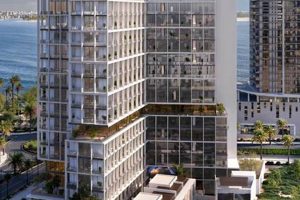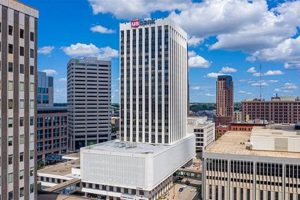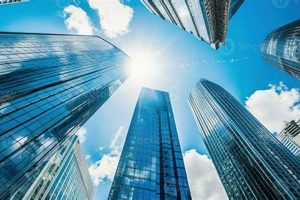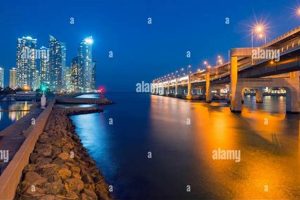Skyscraper design refers to the specialized field of architecture and engineering focused on creating tall, multi-story structures. These buildings are designed to maximize vertical space and accommodate a large number of occupants within a relatively small footprint on the ground. Skyscrapers have become iconic landmarks in many major cities around the world, reshaping skylines and transforming urban landscapes.
The design of skyscrapers presents unique challenges that require careful consideration of various factors, including structural stability, wind resistance, efficient use of space, and energy efficiency. Architects and engineers collaborate to develop innovative solutions that meet these challenges while also ensuring the safety and comfort of the building’s occupants. Advancements in building materials, construction techniques, and architectural design have pushed the boundaries of skyscraper design, leading to the creation of increasingly taller and more complex structures.
Skyscrapers offer numerous advantages, including increased population density in urban areas, reduced urban sprawl, and improved access to sunlight and natural ventilation. They can also serve as mixed-use developments, incorporating residential, commercial, retail, and even recreational spaces within a single structure. Additionally, skyscrapers can contribute to sustainability efforts by incorporating energy-efficient features, reducing carbon emissions, and promoting efficient land use. They are a testament to human ingenuity and the continuous pursuit of architectural excellence.
1. Height
In skyscraper design, height is a defining characteristic that sets these structures apart from other architectural forms. Pushing the boundaries of vertical construction involves overcoming significant engineering challenges to create increasingly taller and more slender buildings. Achieving exceptional height requires careful consideration of various factors, including structural stability, wind resistance, material selection, and construction techniques.
The pursuit of height in skyscraper design has led to the development of innovative structural systems and materials. For instance, supertall skyscrapers often employ reinforced concrete cores and steel frames to provide exceptional strength and rigidity. Advanced composite materials, such as carbon fiber reinforced polymers, offer high strength-to-weight ratios, allowing for lighter and more efficient structures. These advancements enable architects and engineers to design skyscrapers that soar to unprecedented heights while maintaining structural integrity.
Beyond its aesthetic appeal, height in skyscraper design also offers practical advantages. Taller buildings can accommodate a greater number of occupants and functions within a limited footprint, reducing urban sprawl and promoting efficient land use. They can also provide panoramic views, enhance natural ventilation, and offer opportunities for mixed-use developments, combining residential, commercial, and public spaces within a single structure.
However, achieving exceptional height comes with its own set of challenges. Wind loads, seismic forces, and gravity exert immense pressure on tall buildings, requiring robust structural designs to ensure stability and safety. Architects and engineers must carefully consider the dynamic behavior of these structures under various loading conditions and employ innovative solutions, such as tuned mass dampers or active control systems, to mitigate sway and vibrations.
In conclusion, the pursuit of height in skyscraper design is a testament to human ingenuity and the continuous advancement of architectural and engineering practices. By pushing the boundaries of vertical construction, architects and engineers create iconic landmarks that reshape skylines, optimize space utilization, and offer unique experiences for occupants while navigating the challenges associated with exceptional height.
2. Structure
In the realm of skyscraper design, structural integrity is paramount to ensure the stability and resilience of these towering structures against the relentless forces of nature. Achieving structural soundness involves a meticulous interplay of architectural and engineering expertise, where every element works in harmony to withstand gravity, wind loads, seismic forces, and other potential threats.
- Foundation and Core: The Bedrock of Stability
The foundation, often extending deep into the earth, acts as the bedrock of a skyscraper, anchoring it firmly against gravitational forces. The core, typically a central vertical structure made of reinforced concrete or steel, provides the backbone of the building, resisting lateral forces and ensuring overall stability. - Exoskeleton and Facade: A Symphony of Strength and Aesthetics
The exoskeleton, a framework of steel or concrete beams and columns, forms the external skeleton of the skyscraper, providing structural support and defining its shape. The facade, the exterior skin of the building, not only contributes to the aesthetics but also plays a crucial role in wind resistance and energy efficiency. - Wind Engineering: Dancing with the Forces of Nature
Skyscrapers are subjected to immense wind forces, which can cause swaying and vibrations. Wind engineering involves the study of wind patterns and the design of structures to withstand these forces. Architects and engineers employ various techniques, such as tuned mass dampers and aerodynamic shaping, to mitigate wind-induced oscillations. - Seismic Resilience: Standing Strong Amidst Tremors
In earthquake-prone regions, skyscrapers must be designed to withstand seismic forces. Structural engineers employ base isolation systems, energy-absorbing materials, and advanced damping technologies to reduce the impact of ground vibrations and protect occupants and the structure.
By carefully considering each of these structural elements and employing innovative design solutions, architects and engineers create skyscrapers that are not only visually stunning but also safe and resilient, capable of withstanding the forces of nature and ensuring the well-being of their occupants.
3. Facade
In skyscraper design, the facade plays a pivotal role in shaping the building’s exterior aesthetics and functionality. It serves as the interface between the interior and exterior environments, influencing the building’s overall appearance, energy efficiency, and occupant comfort.
The facade’s aesthetic impact is undeniable. Architects use a variety of materials, textures, and colors to create visually striking exteriors that reflect the building’s intended purpose and compleme
nt the surrounding urban fabric. The facade can also contribute to the building’s identity and become a recognizable landmark, such as the glass curtain walls of the John Hancock Center in Chicago or the intricate terracotta facade of the Flatiron Building in New York City.
Beyond aesthetics, the facade plays a crucial role in the building’s functionality. It provides a protective barrier against the elements, shielding the interior from wind, rain, and sunlight. Advanced facade systems incorporate energy-efficient glazing, insulation, and shading devices to reduce heat gain and loss, contributing to the building’s overall sustainability. Some facades even integrate photovoltaic panels or other renewable energy technologies to generate electricity.
The facade also contributes to occupant comfort by regulating natural light and ventilation. Large windows and transparent facades allow natural light to penetrate deep into the building, reducing the need for artificial lighting and creating a more pleasant and healthy indoor environment. Operable windows or systems integrated into the facade allow occupants to control the flow of fresh air, improving indoor air quality and thermal comfort.
In conclusion, the facade is an integral component of skyscraper design, influencing both the building’s aesthetics and functionality. By carefully considering the materials, design, and performance of the facade, architects and engineers create skyscrapers that are not only visually appealing but also energy-efficient, comfortable, and sustainable.
4. Interior design
Interior design plays a crucial role in skyscraper design, as it directly impacts the functionality, aesthetics, and overall user experience of these towering structures. By carefully crafting the interior spaces, architects and designers create environments that enhance occupant comfort, well-being, and productivity.
Functional design is essential in skyscrapers, where space is often limited and vertical circulation is a key consideration. Interior designers optimize, ensuring efficient flow of movement throughout the building. They create flexible and adaptable spaces that can accommodate diverse needs and activities, from work and leisure to living and hospitality.
Visual appeal is equally important in skyscraper design. Interior designers use lighting, materials, and furnishings to create visually stimulating and aesthetically pleasing spaces. Natural light is maximized through large windows and skylights, reducing the need for artificial lighting and creating a more inviting atmosphere. The choice of materials and colors influences the overall ambiance of the interior, evoking a sense of luxury, comfort, or modernity.
Real-life examples of exceptional skyscraper interior design include The Shard in London, known for its stunning views and luxurious amenities, and the Burj Khalifa in Dubai, which features elegant and sophisticated interiors that reflect the building’s iconic status. These examples showcase how interior design can elevate skyscraper living and working experiences.
Understanding the connection between interior design and skyscraper design is crucial for architects, developers, and interior designers. It emphasizes the importance of creating not only visually striking buildings but also functional and comfortable spaces that cater to the needs of occupants. By integrating interior design as an integral part of skyscraper design, we can create built environments that are both aesthetically pleasing and conducive to human well-being.
5. Sustainability
In the realm of skyscraper design, sustainability has emerged as a critical consideration, driven by the need to reduce the environmental impact of these towering structures. By incorporating eco-friendly features, architects and engineers can create skyscrapers that are not only visually impressive but also responsible stewards of the environment.
- Energy Efficiency: Conserving Resources, Reducing Emissions
Skyscrapers consume a significant amount of energy for lighting, heating, cooling, and other operations. By implementing energy-efficient measures, such as high-performance glazing, LED lighting, and smart building management systems, architects can minimize energy consumption and reduce greenhouse gas emissions. - Water Conservation: Preserving a Precious Resource
Water conservation is another key aspect of sustainable skyscraper design. Low-flow fixtures, rainwater harvesting systems, and drought-tolerant landscaping can significantly reduce water usage. Additionally, graywater recycling systems can further minimize the demand for potable water. - Material Selection: Embracing Sustainable Choices
The choice of materials used in skyscraper construction has a significant environmental impact. Sustainable materials, such as recycled steel, low-VOC paints, and FSC-certified wood, can reduce the carbon footprint of the building. Green roofs and facades can also contribute to sustainability by absorbing rainwater, reducing heat gain, and providing habitats for wildlife. - Renewable Energy Integration: Harnessing Natural Resources
Skyscrapers offer unique opportunities for integrating renewable energy sources. Solar panels, wind turbines, and geothermal systems can be incorporated into the design to generate clean energy and reduce reliance on fossil fuels. This not only reduces operating costs but also contributes to a greener urban environment.
By embracing sustainability in skyscraper design, architects and engineers can create buildings that minimize their environmental impact, enhance occupant well-being, and contribute to a more sustainable future. These eco-friendly features are not only responsible choices but also represent a competitive advantage in a market increasingly demanding sustainable solutions.
6. Technology
In the realm of skyscraper design, technology plays a pivotal role in enhancing operational efficiency and occupant comfort. By integrating advanced systems into these towering structures, architects and engineers create intelligent buildings that respond to the needs of their occupants and optimize building performance.
One of the key aspects of technology in skyscraper design is automated building management systems (BMS). These systems integrate various building systems, such as HVAC, lighting, and security, into a central platform. BMS allows for real-time monitoring and control of these systems, enabling efficient energy management, reduced operating costs, and enhanced occupant comfort. For instance, BMS can automatically adjust lighting levels based on natural light availability, reducing energy consumption while maintaining comfortable illumination.
Another important aspect is the integration of smart technologies for occupant convenience. Mobile apps and touchscreens provide occupants with intuitive control over building functions, such as room temperature, lighting, and window blinds. This empowers occupants to personalize their workspace or living environment and enhances their overall experience within the skyscraper.
Furthermore, advanced security systems are essential in skysc
raper design, ensuring the safety and well-being of occupants. These systems include access control, surveillance cameras, and intrusion detection technologies. By integrating these systems into the building’s infrastructure, architects and engineers create a secure environment for occupants and protect the building from unauthorized access or threats.
In conclusion, the integration of advanced technology in skyscraper design is crucial for efficient operation and occupant comfort. By embracing innovative systems and solutions, architects and engineers create intelligent buildings that respond to the needs of their occupants, optimize performance, and enhance the overall experience within these towering structures.
7. Safety
In the realm of skyscraper design, safety is paramount. It encompasses a multitude of measures and considerations aimed at protecting occupants and the structure from various hazards, ensuring the well-being and resilience of these towering edifices.
One of the key aspects of safety in skyscraper design is structural integrity. Engineers employ robust materials, advanced construction techniques, and innovative structural systems to ensure that skyscrapers can withstand extreme forces, such as high winds, earthquakes, and even terrorist attacks. Fire safety is another critical concern, and skyscrapers are equipped with fire-resistant materials, compartmentalization, and advanced fire suppression systems to prevent the spread of flames and smoke.
Life safety measures are also of utmost importance. Skyscrapers are designed with multiple evacuation routes, emergency lighting, and communication systems to facilitate safe and efficient evacuation in case of an emergency. Access control systems, surveillance cameras, and security personnel contribute to the overall safety and security of occupants.
Real-life examples showcase the practical significance of safety in skyscraper design. The Burj Khalifa, the world’s tallest building, is equipped with an advanced fire safety system that includes over 12,000 sprinklers and a dedicated firefighting elevator. The Shanghai Tower, another supertall skyscraper, features a unique double-skin facade that acts as a buffer against strong winds and provides additional fire protection.
Understanding the connection between safety and skyscraper design is essential for architects, engineers, and building managers. By prioritizing safety measures, they create structures that are not only visually impressive but also safe and resilient, ensuring the well-being of occupants and the longevity of these architectural marvels.
8. Functionality
In the realm of skyscraper design, functionality plays a pivotal role in creating structures that not only meet the practical requirements of occupants but also enhance their well-being and productivity. Architects and designers carefully consider the intended use of the skyscraper, whether it be residential, commercial, or mixed-use, and tailor the design to suit the specific needs and activities that will take place within the building.
For instance, a skyscraper designed primarily for residential use will prioritize features such as comfortable living spaces, efficient layouts, and amenities that cater to the needs of residents. This may include well-equipped kitchens, spacious balconies, and communal areas that foster a sense of community. On the other hand, a skyscraper designed for commercial purposes will focus on creating flexible and adaptable workspaces that can accommodate a variety of business activities. This may involve open floor plans, ample natural light, and state-of-the-art technology to support productivity.
Understanding the connection between functionality and skyscraper design is crucial for architects, developers, and building managers. By prioritizing the needs of occupants and designing spaces that are tailored to their specific purposes, they create skyscrapers that are not only visually impressive but also highly functional and enjoyable to live and work in.
9. Context
In the realm of skyscraper design, context plays a crucial role in shaping the overall character and impact of these towering structures. Architects and urban planners carefully consider the surrounding environment and urban fabric to ensure that skyscrapers complement their surroundings and contribute positively to the cityscape.
- Harmony with the Built Environment
Skyscrapers should harmoniously blend with the existing built environment, respecting the scale, style, and architectural character of neighboring buildings. This can involve incorporating elements of traditional architecture, using compatible materials, or designing facades that complement the surrounding cityscape.
- Respect for the Natural Environment
Skyscrapers should be designed with sensitivity to the natural environment, minimizing their impact on ecosystems and respecting the views and vistas of surrounding areas. This may involve incorporating green spaces, using sustainable materials, and designing facades that reduce light pollution.
- Integration with Public Spaces
Skyscrapers should be integrated with public spaces, creating vibrant and accessible urban environments. This can involve creating plazas, parks, and public art installations at the base of the building, or designing sky gardens and rooftop terraces that offer panoramic views to the public.
- Contribution to Urban Identity
Skyscrapers can become iconic landmarks that define a city’s skyline and contribute to its unique identity. By creating visually striking and architecturally significant structures, skyscrapers can enhance the city’s appeal and attract visitors and investment.
Understanding the connection between context and skyscraper design is essential for architects, developers, and urban planners. By carefully considering the surrounding environment and urban fabric, they can create skyscrapers that not only meet functional requirements but also enhance the overall quality and character of the city.
Frequently Asked Questions about Skyscraper Design
Skyscraper design is a complex and fascinating field that involves a wide range of considerations. Here are answers to some frequently asked questions about this topic:
Question 1: What are the key challenges in designing skyscrapers?
Skyscraper design presents several unique challenges, including structural stability, wind resistance, efficient use of space, and energy efficiency. Engineers and architects must carefully consider these factors to ensure the safety and functionality of these towering structures.
Question 2: How do architects ensure the structural stability of skyscrapers?
Structural stability is paramount in skyscraper design. Architects and engineers employ various techniques to ensure that skyscrapers can withstand strong winds, earthquakes, and other forces. These techniques include using reinforced concrete cores, steel frames, and innovative structural systems.
Question 3: What are some of the most important factors to consider when designing the facade of a skyscra
per?
The facade of a skyscraper plays a crucial role in its overall appearance and functionality. Architects must consider factors such as aesthetics, energy efficiency, wind resistance, and occupant comfort when designing the facade.
Question 4: How do architects create sustainable skyscrapers?
Sustainability is becoming increasingly important in skyscraper design. Architects incorporate eco-friendly features such as energy-efficient lighting, water-saving fixtures, and renewable energy sources to reduce the environmental impact of these buildings.
Question 5: What are some of the latest trends in skyscraper design?
Skyscraper design is constantly evolving. Some of the latest trends include the use of mixed-use spaces, the incorporation of smart technology, and the focus on occupant well-being.
Question 6: How do skyscrapers contribute to the urban environment?
Skyscrapers can have a significant impact on the urban environment. They can create new landmarks, enhance the city’s skyline, and provide valuable office, residential, and commercial space. However, it is important to carefully consider the context and surrounding environment when designing skyscrapers to ensure they complement the cityscape and contribute positively to the urban fabric.
These are just a few of the frequently asked questions about skyscraper design. As this field continues to evolve, we can expect to see even more innovative and sustainable skyscrapers gracing our skylines in the future.
Transition to the next article section:
The design of skyscrapers is a complex and fascinating field that involves a wide range of considerations. In this article, we have explored some of the key aspects of skyscraper design, including structural stability, facade design, sustainability, and the latest trends. By understanding these factors, we can appreciate the remarkable achievements of architects and engineers who create these towering structures that shape our skylines and enhance our urban environments.
Skyscraper Design Tips
Skyscraper design is a complex and challenging field that requires careful consideration of various factors. Here are five tips to help you create safe, functional, and aesthetically pleasing skyscrapers:
Tip 1: Prioritize Structural StabilityEnsure the structural stability of your skyscraper by using reinforced concrete cores, steel frames, and innovative structural systems. These elements will help the building withstand strong winds, earthquakes, and other forces.Tip 2: Design an Efficient FacadeThe facade of a skyscraper plays a crucial role in its overall appearance and functionality. Consider factors such as aesthetics, energy efficiency, wind resistance, and occupant comfort when designing the facade.Tip 3: Incorporate Sustainable FeaturesSustainability is becoming increasingly important in skyscraper design. Consider using eco-friendly features such as energy-efficient lighting, water-saving fixtures, and renewable energy sources to reduce the environmental impact of the building.Tip 4: Utilize Advanced TechnologyIntegrate advanced technology into your skyscraper design to enhance operational efficiency and occupant comfort. Consider using automated building management systems, smart technologies for occupant convenience, and advanced security systems.Tip 5: Consider the ContextWhen designing a skyscraper, carefully consider the surrounding environment and urban fabric. Ensure that the building complements its surroundings, respects the scale and style of neighboring buildings, and contributes positively to the cityscape.
By following these tips, you can create skyscrapers that are not only visually stunning but also safe, functional, sustainable, and respectful of their surroundings.
Conclusion:
Skyscraper design is a complex and rewarding field that offers unique challenges and opportunities. By embracing innovation, sustainability, and a deep understanding of structural engineering and architectural principles, you can create skyscrapers that will stand the test of time and enhance the urban landscape.
Conclusion
Skyscraper design has emerged as a captivating and multifaceted field that pushes the boundaries of architectural ingenuity and engineering prowess. Throughout this article, we have explored the intricate aspects of skyscraper design, including structural stability, facade design, sustainability, technology integration, and contextual considerations.
Skyscrapers stand as testaments to human ambition and innovation, reshaping skylines and transforming urban landscapes. By carefully considering the interplay of these design elements, architects and engineers create structures that not only meet functional requirements but also enhance the urban environment and contribute to our collective architectural heritage. As we continue to strive for greater heights and sustainable solutions, skyscraper design will undoubtedly continue to evolve, pushing the limits of what is possible and inspiring generations to come.







